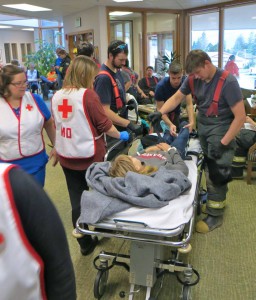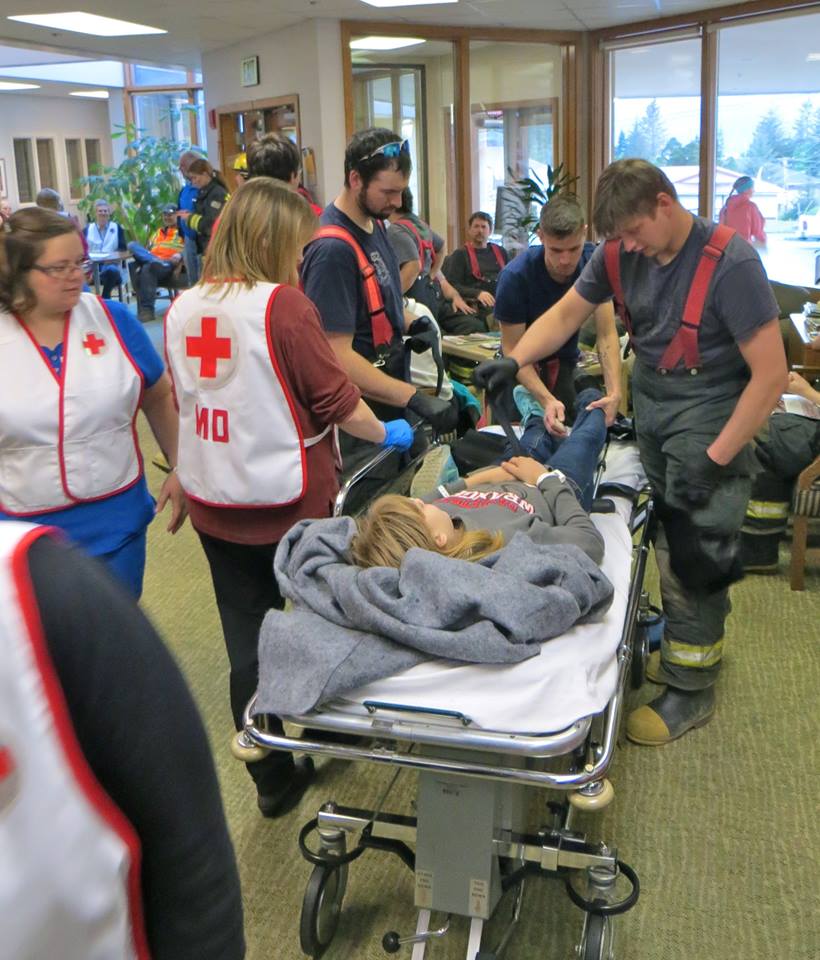 On Wednesday, May 4th at 5:35 pm the “All Out” siren signaled the beginning of a Disaster Drill in Wrangell, a combined effort of the Wrangell Fire Department, Wrangell Medical Center and the Department of Transportation.
On Wednesday, May 4th at 5:35 pm the “All Out” siren signaled the beginning of a Disaster Drill in Wrangell, a combined effort of the Wrangell Fire Department, Wrangell Medical Center and the Department of Transportation.
The disaster drill scenario: A passenger jet accelerating for takeoff, ingested foreign object debris in the right engine resulting in engine failure. While attempting to abort the takeoff, the aircraft slid off the runway. The forward section of the jet was in the water. The left wing buckled. The wing fuel tank ruptured, fuel ignited and engulfed the left side of the aircraft in flames.
Paul Khera, Airport Safety & Security Officer for the Alaska Department of Transportation and Public Facilities in an email explained the D.O.T. & P.F. staff developed the Wrangell drill scenario based on the location. The effort was coordinated with the local airport manager and statewide aviation staff.
The Federal Aviation Administration increased the number of volunteers required for the drill to 40 volunteers in 2016 to make the plane crash scenario more realistic. William Bloom, Wrangell Rural Airport Foreman, contacted Wrangell’s local Volunteer Fire Department to solicit the required volunteers for the drill.
According to Khera, the greatest challenge in organizing a disaster drill is getting enough volunteers to fill the role of accident victims. However, he said, Wrangell has a strong volunteer community and easily came up with 52 volunteers to assist in the drill, which could possibly be a record in Southeast Alaska.
Volunteers of all ages met at the Wrangell Fire Hall where they were given instructions and special effect make-up to imitate wounds and injuries. Instructions were given to volunteers on how to behave and what to do if an actual emergency were to occur during the drill. For extra safety, the code word “wolf” was given to use in case of an actual emergency. Each drill victim volunteer chose a trauma card that indicated a specific injury and symptoms. At the accident scene, first responders used the information on the trauma cards to appropriately treat each victim.
On scene at the airport, patients went into action and positioned themselves according to the injury listed on their trauma cards. An actual fire was started for the drill by D.O.T. staff. Wrangell’s D.O.T. staff and first responders went into action addressing the drill as if it were the real deal. Responders color coded each patient, indicating the nature and severity of the individual’s injury and those victims were transported to Wrangell Medical Center for treatment.
Upon arrival at the hospital, emergency staff used the color codes to prioritize and determine whether victims were critical and needing immediate assistance or if patients could wait to be treated. Public Information Officer Kris Reed explained the procedure reporting 14 green patients; those who had injuries but would be able to wait for treatment. 10 yellow patients; not yet critical but needing attention soon). 18 red; critical patients of which 6 were medevaced. Reed explained the telephone tree call out process that is used when there is a need greater than those on duty can manage. The drill included WMC officials contacting medevac companies to fly critical patients out of town.
One volunteer complimented the first responders saying they took the situation seriously while treating and transporting him to the hospital.
After being released, most of the volunteer patients went back to the fire hall, still in injury make-up, to enjoy grilled burgers and hot dogs while the fire department crew cleaned and put away their equipment preparing for their next call.













